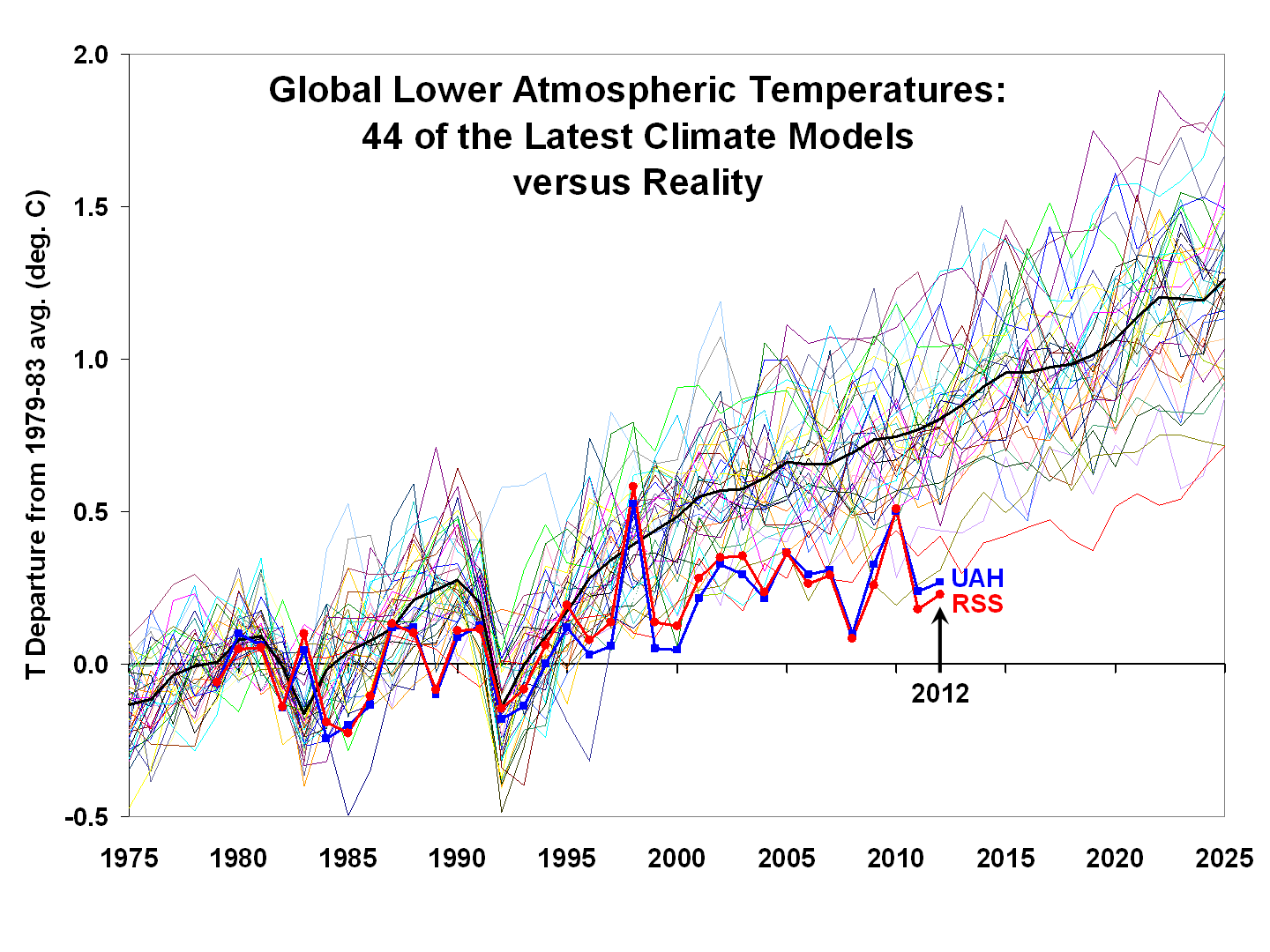"Clearly, there is increasing divergence over the years between the satellite observations (UAH, RSS) and the models. The reasons for the disagreement are not obvious, since there are at least a few possibilities:
1) the real climate system is not as sensitive to increasing CO2 as the models are programmed to be (my preferred explanation)
2) the extra surface heating from more CO2 has been diluted more than expected by increased mixing with cooler, deeper ocean waters (Trenberth’s explanation)
3) increased manmade aerosol pollution is causing a cooling influence, partly mitigating the manmade CO2 warming
If I am correct (explanation #1), then we will continue to see little warming into the future. Additional evidence for lower climate sensitivity in the above plot is the observed response to the 1991 Pinatubo eruption: the temporary temperature dip in 1992-93, and subsequent recovery, is weaker in the observations than in the models. This is exactly what would be predicted with lower climate sensitivity.
On the other hand, if Trenberth is correct (explanation #2), then there should be a period of rapid surface warming that resumes at some point, since the climate system must eventually try to achieve radiative energy equilibrium. Of course, exactly when that might be is unknown."There are at least four reasons why the Trenberth explanation (#2) is incorrect:
1. Longwave infrared from greenhouse gases only penetrates a few microns into water to cause evaporative cooling of the ocean surface, not heating
2. If the “missing heat” has gone to the deep oceans, it should have been picked up first in the upper oceans by ARGO, but wasn’t.
3. Heat rises, an overwhelming negative feedback to any alleged “increased mixing.” Furthermore, there is no reason to believe the oceans are undergoing "increased mixing" with respect to the past.
4. The heat capacity of the ocean is over 1000 times greater than the atmosphere. Atmospheric temperature changes [and CO2] follow ocean temperature changes. The oceans control the atmospheric temperature, and the tail doesn’t wag the dog.
Excerpt from Dr. Spencer's post:
Global Warming Slowdown: The View from Space
April 16th, 2013 by Roy W. Spencer, Ph. D.
Since the slowdown in surface warming over the last 15 years has been a popular topic recently, I thought I would show results for the lower tropospheric temperature (LT) compared to climate models calculated over the same atmospheric layers the satellites sense.
Courtesy of John Christy, and based upon data from the KNMI Climate Explorer, below is a comparison of 44 climate models versus the UAH and RSS satellite observations for global lower tropospheric temperature variations, for the period 1979-2012 from the satellites, and for 1975 – 2025 for the models:


The dark line in the above plot is the 44-model average, and it approximately represents what the IPCC uses for its official best estimate of projected warming. Obviously, there is a substantial disconnect between the models and observations for this statistic.
see also
ReplyDeletehttp://wattsupwiththat.com/2013/04/05/a-comparison-of-the-earths-climate-sensitivity-to-changes-in-the-nature-of-the-initial-forcing/#comment-1267403
http://bobtisdale.wordpress.com/2013/04/17/a-different-perspective-on-trenberths-missing-heat-the-warming-of-the-global-oceans-0-to-2000-meters-in-deg-c/
ReplyDeleteTrenberth's "explanation" is merely a disguised admission that his lot
ReplyDeletehave guessed another parameter wrong. Anyway, Heat going into a heat sink?
Whatever next!
http://judithcurry.com/2012/01/24/missing-heat-isnt-missing-after-all/
ReplyDeletePertinent comment on the uncertainties in ocean heat data
ReplyDeletehttp://joannenova.com.au/2013/05/ocean-temperatures-is-that-warming-statistically-significant/#comment-1275351